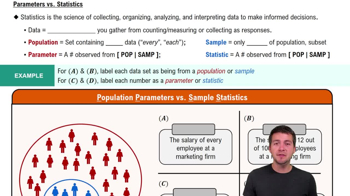Here are the essential concepts you must grasp in order to answer the question correctly.
Population Parameter
A population parameter is a numerical value that summarizes a characteristic of an entire population. It is a fixed value, often unknown, that represents the true measure of a specific attribute across all individuals in the population. For example, the percentage of all college board members who believe their institution is inclusive would be a population parameter.
Recommended video:
Parameters vs. Statistics
Sample Statistic
A sample statistic is a numerical value that summarizes a characteristic of a sample, which is a subset of the population. It is used to estimate the population parameter and can vary from sample to sample. In the given question, the 89% figure derived from the survey of 919 college board members is a sample statistic, as it reflects the opinion of only a portion of the entire population of college board members.
Recommended video:
Sampling Distribution of Sample Proportion
Sampling and Inference
Sampling and inference involve selecting a subset of individuals from a larger population to make generalizations about that population. The process includes collecting data from the sample and using statistical methods to infer characteristics of the population. Understanding this concept is crucial for interpreting the results of the survey and determining whether the reported percentage accurately reflects the views of all college board members.
Recommended video:
Sampling Distribution of Sample Proportion
 Verified step by step guidance
Verified step by step guidance Verified video answer for a similar problem:
Verified video answer for a similar problem:



 2:13m
2:13m